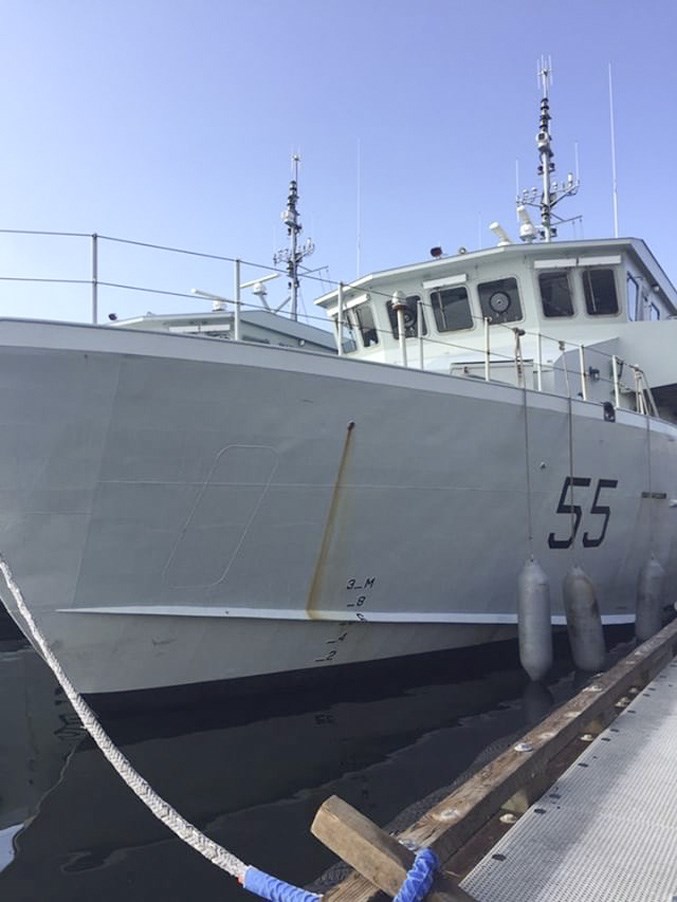A local sea cadet is navigating toward a career on the water thanks to a seamanship deployment this fall. Petty officer second-class Liam Deuel, of the Okotoks Sea Cadets, had the unique opportunity to spend a week on-board a navy training vessel in October, off the coast of Vancouver Island in the Georgia Strait. They began at the Esquimalt naval base at near Victoria. “It showed me my dream job, because being a chief boatswain mate is definitely my dream job now,” said Deuel, who is 16 years old and being homeschooled in Grade 11. “I was thinking of joining, but until then I didn’t have a plan. I was thinking I might as well. But now this is what I want to be.” He was chosen from among hundreds of sea cadets across the country to be one of 32 youth on the seamanship deployment, said Okotoks Sea Cadet C.O. Pam Mattock. “We put his name in for it because P.O. Deuel just came back from a summer camp where he was there for six weeks and learned seamanship, so what he learned put a great deal into this deployment,” said Mattock. “He was excited to do it, very nervous at first, but excited.” He was just as excited and nervous to share his experience with fellow cadets and the community. The deployment consisted of six intense days of training on two Orca patrol-class training units, he said. Patrol-class ships would typically do patrols and warn other navy vessels of any trouble at sea, he said. “Each vessel had 16 cadets on it and eight navy crew,” said Deuel. “We were on the 55 Orca and the 56 Raven.” On the Orca, the 16 cadets rotated through multiple positions to train in seamanship for the week, he said. The first job of the day was called “slipping the ship,” which entails untying the ship and disembarking from the dock where it stopped the night before. Being helmsman was another position once the ship was travelling – and it happened to be Deuel’s favourite. The helmsman drives the ship using a number of instruments that indicate the speed, bearing, and rudder direction. “After a while it gets tiring, but I still liked it the best,” said Deuel. “You’re sitting there holding a wheel, making sure you stay the correct bearing for half an hour.” There are two lookouts on the ship as well, he said – one on the port, or left, side and one on the starboard, or right, side. Lookouts are mainly watching for buoys, other vessels or debris on the water, and report any findings to the Officer of the Watch. An Officer of the Watch is responsible for ensuring the cadets in each position switch out every half hour, he said. He or she is also responsible for ensuring the anchor remains locked on board. The last position on the deck is the Life Buoy Sentry, who stays at the back of the ship watching for people who fall overboard, he said. “They will have what we call a Kisbee ring, or just a life ring,” said Deuel. “They will hold those so if someone has fallen overboard they can throw it.” Each night, after rotating through the positions all day long, the cadets would bring the ship along side for the night – meaning they would dock the vessel. They pulled in to a new dock every night, he said. After the ship has been docked, the night watch begins, he said. Lights out is at 2200 hours, with the night watch starting half an hour later. “That’s making sure everyone is in bed, the boat does not have any leaks or hull damage, the boat has not been stolen or sunk, and the anchor is still on the devil’s claw, chain stopper and brake,” said Deuel. The daily routine of the ship was enough to pique his interest in a career, but the drills done periodically throughout the day made it even more appealing, he said. Drills ranged from how to deal with fire aboard the ship to handling a man overboard situation, rudder control breakdown, a leak in the hull or having to abandon ship, he said. Though the sleeping conditions were interesting for a six-foot-one cadet – his middle bunk was only about six-and-a-half feet long and less than two-feet high – Deuel said life aboard the ship called his name. “It taught me a lot of leadership and it gave me more confidence about taking action and it taught me a lot of jobs that I didn’t know of until then,” he said. He plans to finish high school and attend a boatswain mate camp in the summer of 2019 to learn more about working on a ship. Ultimately, Deuel would like to be a boatswain mate on a coast guard vessel, he said. “It set me a path,” said Deuel. “It was really a great experience.”




